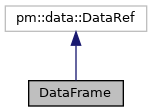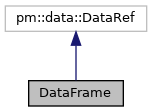
|
ParaMonte MATLAB 3.0.0
Parallel Monte Carlo and Machine Learning Library
See the latest version documentation. |

|
ParaMonte MATLAB 3.0.0
Parallel Monte Carlo and Machine Learning Library
See the latest version documentation. |
This is the abstract class for generating instances of objects that can contain basic attributes required for tabular read-only access to a MATLAB table-compatible data stored externally.
More...


Public Member Functions | |
| function | DataFrame (in dfref) |
| Generate an return an object of class pm.container.DataFrame from the input dataframe or its specified input reference. More... | |
| function | copy (in self) |
Generate and return a table copy of the dataframe contained in the user-specified input dfref to the constructor of the parent object.More... | |
| function | ncol (in self) |
Generate and return the number of columns in the user-specified dataframe dfref at the time of constructing the parent object.More... | |
| function | nrow (in self) |
Generate and return the number of rows in the user-specified dataframe dfref at the time of constructing the parent object.More... | |
| function | rowslog (in self, in count, in start, in stop) |
Generate and return a natural logarithmically-spaced range of indices from the row indices of the input dataframe dfref to the parent object.More... | |
This is the abstract class for generating instances of objects that can contain basic attributes required for tabular read-only access to a MATLAB table-compatible data stored externally.
This class is merely a convenience read-only wrapper to reference external tabular data as table.
This class primarily exist to facilitate bypassing the lack of references and pointers in MATLAB.
Final Remarks ⛓
If you believe this algorithm or its documentation can be improved, we appreciate your contribution and help to edit this page's documentation and source file on GitHub.
For details on the naming abbreviations, see this page.
For details on the naming conventions, see this page.
This software is distributed under the MIT license with additional terms outlined below.
This software is available to the public under a highly permissive license.
Help us justify its continued development and maintenance by acknowledging its benefit to society, distributing it, and contributing to it.
Definition at line 24 of file DataFrame.m.
| function DataFrame::DataFrame | ( | in | dfref | ) |
Generate an return an object of class pm.container.DataFrame from the input dataframe or its specified input reference.
This is the constructor of the class pm.container.DataFrame.
| [in] | dfref | : The input MATLAB 2D matrix or table containing the target dataset or function handle that takes no arguments and returns the dataset. Specifying a function handle is superior to specifying the dataset directly, because the function handle will always allow the use of the most updated version of the user table or matrix. (optional. default = table(zeros(0, 0))) |
self : The output scalar object of class pm.container.DataFrame.
Possible calling interfaces ⛓
Example usage ⛓
Final Remarks ⛓
If you believe this algorithm or its documentation can be improved, we appreciate your contribution and help to edit this page's documentation and source file on GitHub.
For details on the naming abbreviations, see this page.
For details on the naming conventions, see this page.
This software is distributed under the MIT license with additional terms outlined below.
This software is available to the public under a highly permissive license.
Help us justify its continued development and maintenance by acknowledging its benefit to society, distributing it, and contributing to it.
| function DataFrame::copy | ( | in | self | ) |
Generate and return a table copy of the dataframe contained in the user-specified input dfref to the constructor of the parent object.
This class method offers the only way to access the user-specified dataframe.
The underlying logic behind the use of function to access the dataframe originates from the lack of the concept of references (pointers) in the MATLAB computing language.
| [in,out] | self | : The implicitly-passed input argument representing the parent object of the method. |
df : The output scalar MATLAB table a full copy of the dataframe contained in the user-specified input dfref passed to the constructor of the parent object.
Possible calling interfaces ⛓
Final Remarks ⛓
If you believe this algorithm or its documentation can be improved, we appreciate your contribution and help to edit this page's documentation and source file on GitHub.
For details on the naming abbreviations, see this page.
For details on the naming conventions, see this page.
This software is distributed under the MIT license with additional terms outlined below.
This software is available to the public under a highly permissive license.
Help us justify its continued development and maintenance by acknowledging its benefit to society, distributing it, and contributing to it.
| function DataFrame::ncol | ( | in | self | ) |
Generate and return the number of columns in the user-specified dataframe dfref at the time of constructing the parent object.
This class method is a handy shorthand for size(self.dfref, 2), particularly useful for specifying a range of indices of columns in visualization tasks.
| [in,out] | self | : The implicitly-passed input argument representing the parent object of the method. |
count : The output scalar MATLAB whole-number representing the number of columns in the dfref component of the parent object.
Possible calling interfaces ⛓
Final Remarks ⛓
If you believe this algorithm or its documentation can be improved, we appreciate your contribution and help to edit this page's documentation and source file on GitHub.
For details on the naming abbreviations, see this page.
For details on the naming conventions, see this page.
This software is distributed under the MIT license with additional terms outlined below.
This software is available to the public under a highly permissive license.
Help us justify its continued development and maintenance by acknowledging its benefit to society, distributing it, and contributing to it.
| function DataFrame::nrow | ( | in | self | ) |
Generate and return the number of rows in the user-specified dataframe dfref at the time of constructing the parent object.
This class method is a handy shorthand for size(self.dfref, 2), particularly useful for specifying a range of indices of rows to visualize.
| [in,out] | self | : The implicitly-passed input argument representing the parent object of the method. |
count : The output scalar MATLAB whole-number representing the number of rows in the dfref component of the parent object.
Possible calling interfaces ⛓
Final Remarks ⛓
If you believe this algorithm or its documentation can be improved, we appreciate your contribution and help to edit this page's documentation and source file on GitHub.
For details on the naming abbreviations, see this page.
For details on the naming conventions, see this page.
This software is distributed under the MIT license with additional terms outlined below.
This software is available to the public under a highly permissive license.
Help us justify its continued development and maintenance by acknowledging its benefit to society, distributing it, and contributing to it.
| function DataFrame::rowslog | ( | in | self, |
| in | count, | ||
| in | start, | ||
| in | stop | ||
| ) |
Generate and return a natural logarithmically-spaced range of indices from the row indices of the input dataframe dfref to the parent object.
This method is a convenience wrapper around function pm.array.logrange.
| [in,out] | self | : The implicitly-passed input/output argument representing the parent object of the method. |
| [in] | count | : The input scalar MATLAB whole-number (integer) representing the maximum size of the output range. Due to rounding operation involved in creating the output range, it is impossible to prespecify the output range size, only the maximum. (optional, default = 1000) |
| [in] | start | : The input scalar MATLAB whole-number (integer) representing the starting point of the output range. It must be a number in the range [1, size(self.dfref, 1)]. Otherwise, the value max(1, min(start, self.nrow())) will be used.(optional, default = 1) |
| [in] | stop | : The input scalar MATLAB whole-number (integer) representing the stopping point of the output range. It must be a number in the range [1, size(self.dfref, 1)]. Otherwise, the value max(start, min(stop, self.nrow())) will be used.(optional, default = 1) |
indices : The output vector of MATLAB real values containing the set of naturally logarithmically-spaced integer values in the specified input range.
Possible calling interfaces ⛓
Final Remarks ⛓
If you believe this algorithm or its documentation can be improved, we appreciate your contribution and help to edit this page's documentation and source file on GitHub.
For details on the naming abbreviations, see this page.
For details on the naming conventions, see this page.
This software is distributed under the MIT license with additional terms outlined below.
This software is available to the public under a highly permissive license.
Help us justify its continued development and maintenance by acknowledging its benefit to society, distributing it, and contributing to it.